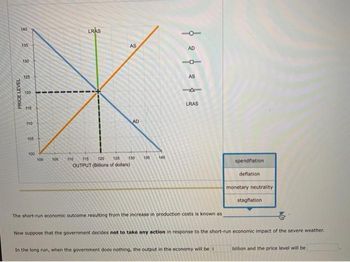6. Economic fluctuations II The following graph shows the short-run aggregate supply curve (AS), the aggregate demand curve (AD), and the long-run aggregate supply curve ( LRAS) for a hypothetical economy. Initially, the expected price level is equal to the actual price level, and the economy is in long-run equilibrium at its natural level of output, $120 billion. Suppose a bout of severe weather drives up agricultural costs, increases the costs of transporting goods and services, and increases the costs of producing goods and services in this economy. Use the graph to help you answer the questions about the short-run and long-run effects of the increase in production costs that follow. (Note: You will not be graded on any adjustments made to the graph.) Hint: For simplicity, ignore any possible impact of the severe weather on the natural level of output. PRICE LEVEL 140 135 130 125 120 115 110 105 100 106 LRAS AS AD 110 116 120 125 130 OUTPUT (Billions of dollars) 130 140 AD P AS A- LRAS 0 PRICE LEVEL 140 135 130 125 120 115 110 105 100 100 105 LRAS 110 115 120 125 OUTPUT (Billions of dollars) AS AD 130 136 140 6 2 4 2 4 3 spendflation In the long run, when the government does nothing, the output in the economy will be s deflation monetary neutrality stagflation The shart-run economic outcome resulting from the increase in production costs is known as Now suppose that the government decides not to take any action in response to the short-run economic impact of the severe weather. billion and the price level will be
6. Economic fluctuations II The following graph shows the short-run aggregate supply curve (AS), the aggregate demand curve (AD), and the long-run aggregate supply curve ( LRAS) for a hypothetical economy. Initially, the expected price level is equal to the actual price level, and the economy is in long-run equilibrium at its natural level of output, $120 billion. Suppose a bout of severe weather drives up agricultural costs, increases the costs of transporting goods and services, and increases the costs of producing goods and services in this economy. Use the graph to help you answer the questions about the short-run and long-run effects of the increase in production costs that follow. (Note: You will not be graded on any adjustments made to the graph.) Hint: For simplicity, ignore any possible impact of the severe weather on the natural level of output. PRICE LEVEL 140 135 130 125 120 115 110 105 100 106 LRAS AS AD 110 116 120 125 130 OUTPUT (Billions of dollars) 130 140 AD P AS A- LRAS 0 PRICE LEVEL 140 135 130 125 120 115 110 105 100 100 105 LRAS 110 115 120 125 OUTPUT (Billions of dollars) AS AD 130 136 140 6 2 4 2 4 3 spendflation In the long run, when the government does nothing, the output in the economy will be s deflation monetary neutrality stagflation The shart-run economic outcome resulting from the increase in production costs is known as Now suppose that the government decides not to take any action in response to the short-run economic impact of the severe weather. billion and the price level will be
Oh no! Our experts couldn't answer your question.
Don't worry! We won't leave you hanging. Plus, we're giving you back one question for the inconvenience.
Submit your question and receive a step-by-step explanation from our experts in as fast as 30 minutes.
You have no more questions left.
Message from our expert:
It looks like you may have submitted a graded question that, per our Honor Code, experts cannot answer. We've credited a question to your account.
Your Question:

Transcribed Image Text:6. Economic fluctuations II
The following graph shows the short-run aggregate supply curve (AS), the aggregate demand curve (AD), and the long-run aggregate supply curve (
LRAS) for a hypothetical economy. Initially, the expected price level is equal to the actual price level, and the economy is in long-run equilibrium at its
natural level of output, $120 billion.
Suppose a bout of severe weather drives up agricultural costs, increases the costs of transporting goods and services, and increases the costs of
producing goods and services in this economy.
Use the graph to help you answer the questions about the short-run and long-run effects of the increase in production costs that follow. (Note: You
will not be graded on any adjustments made to the graph.)
Hint: For simplicity, ignore any possible impact of the severe weather on the natural level of output.
PRICE LEVEL
140
135
130
125
120
115
110
105
100
106
LRAS
AS
AD
110 116 120 125 130
OUTPUT (Billions of dollars)
130 140
AD
P
AS
A-
LRAS
0

Transcribed Image Text:PRICE LEVEL
140
135
130
125
120
115
110
105
100
100
105
LRAS
110
115 120 125
OUTPUT (Billions of dollars)
AS
AD
130
136
140
6 2 4 2 4 3
spendflation
In the long run, when the government does nothing, the output in the economy will be s
deflation
monetary neutrality
stagflation
The shart-run economic outcome resulting from the increase in production costs is known as
Now suppose that the government decides not to take any action in response to the short-run economic impact of the severe weather.
billion and the price level will be
Knowledge Booster
Learn more about
Need a deep-dive on the concept behind this application? Look no further. Learn more about this topic, economics and related others by exploring similar questions and additional content below.Recommended textbooks for you

Principles of Economics 2e
Economics
ISBN:
9781947172364
Author:
Steven A. Greenlaw; David Shapiro
Publisher:
OpenStax

Brief Principles of Macroeconomics (MindTap Cours…
Economics
ISBN:
9781337091985
Author:
N. Gregory Mankiw
Publisher:
Cengage Learning

Principles of Economics 2e
Economics
ISBN:
9781947172364
Author:
Steven A. Greenlaw; David Shapiro
Publisher:
OpenStax

Brief Principles of Macroeconomics (MindTap Cours…
Economics
ISBN:
9781337091985
Author:
N. Gregory Mankiw
Publisher:
Cengage Learning
